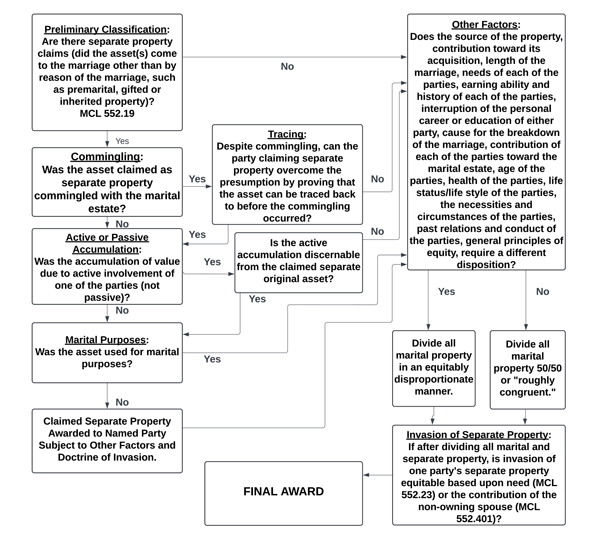
The legal framework governing family law and divorce in Michigan is predominantly established through various state statutes. However, many areas of family law lack explicit statutory guidance, causing judges and legal practitioners to interpret and navigate the law through a complex array of published, and many more unpublished, appellate decisions.
When dividing real and personal property, MCL 552.19 requires the court to divide anything “that shall have come to either party by reason of the marriage.” This followed the common law at the time of enactment in 1846. Likewise, MCL 552.23(1) allows the court to make an added property award “if the estate and effects awarded to either party are insufficient for the suitable support and maintenance” of that party or the children.
The “contribution” and “commingling” statute provides additional discretion to the court: MCL 552.401 allows the court to award one party property of the other “if it appears from the evidence that the party contributed to the acquisition, improve ment or accumulation of the property” in question.1 Frequently, “contribution” and “commingling” are used interchangeably by family law attorneys, although they are different. Finally, MCL 552.18 provides for a division of retirement2 benefits earned during the marriage. These statutes offer an opportunity for skilled legal representation and provide significant discretion for trial courts in their adjudication of family law matters.
The division of marital and separate property is a complex area that is often misunderstood, a challenge I often encounter in my domestic relations mediation practice. Significant case law, including notable decisions such as Sparks, Hanaway, Reeves, Dart, McNamara v. Horner and Pickering,3 and many others, are vital resources for understanding these issues. A systematic approach to analyzing cases involving separate property claims requires thoughtful consideration of various legal precedents and principles.
A decision tree or flowchart analysis may be a valuable analytical tool for conceptualizing the numerous factors and procedural steps involved in cases with separate property issues. This method facilitates a structured approach to understanding the complexities inherent in such cases. A decision tree cannot capture every nuance of every appellate decision on the topic, but it may be a useful starting point for family law attorneys.
See below for chart.

PRELIMINARY CLASSIFICATION
The analysis of property division in divorce proceedings begins with the inquiry into whether any assets held by either party — whether individually or jointly between them or with others — were acquired before the marriage or through means unrelated to the marriage itself. Such considerations include but are not limited to:
- inheritances received by one of the parties;
- gifts conferred upon one party;
- assets owned before the marriage; and
- lump-sum legal settlements awarded for future wage loss or pain and suffering.
These distinctions are crucial because they can significantly influence the equitable distribution of property upon dissolution of the marriage. If all the parties’ assets came to them because of their marital partnership, then the case should continue to a “fair and equitable” disposition between them.4
COMMINGLING OF SEPARATE AND MARITAL PROPERTY
Where a claim arises regarding the separate ownership of assets by one or both parties, the court may decide that the mixing or commingling5 of marital and separate assets has occurred so much that distinguishing between the two becomes impossible. Commingling can occur through the amalgamation of separate and marital assets within a shared account and may also arise within a singular account held in one party’s name, particularly when there is active management of that account by either party.6
The intent of the parties is a critical factor to consider, especially when assets are placed in joint names, used for communal purposes, or relied upon for future needs.7 This intent plays a significant role in the court’s assessment of asset categorization and ownership. Unpublished appellate authority went a step further in holding that distributions from a separate stock account used to pay for marital expenses and household bills (money going out) was sufficient to render the entire segregated asset to be deemed marital.8
“TRACING” AS A DEFENSE TO COMMINGLING
In Michigan, the body of published domestic case law addressing the legal concepts of “commingling” and “tracing” is relatively limited. Tracing invoked as a defense against claims of commingling has received even less attention in judicial opinions. The most straightforward application of the tracing defense arises when a specific sum of money is deposited or withdrawn, and that amount can be directly correlated with another transaction of equal value that occurred within a close temporal framework.
While serial transactions may complicate the analysis, showing a connection between the transactions is still workable through careful examination. It is essential to recognize, however, that each case presents unique circumstances, making it challenging to formulate a universally applicable standard that would be fair across all scenarios; such an approach could invite manipulation of the legal system. The intent of the parties involved — shown by contemporaneous documentation or oral testimony showing whether funds were designated as separate or communal — can significantly influence the outcome. Such intentions may prove to be compelling factors in judicial determinations related to the classification of assets.
ACTIVE OR PASSIVE ACCUMULATION
MCL 552.401 has interpreted the definition of “acquisition, improvement or accumulation” of the claimed separate property to include postmarital “active appreciation” of separate property. It is well established that “passive appreciation” does not automatically turn into marital property.9 However, a considerable area of ambiguity exists between the concepts of purely passive and active appreciation. For instance, a financial account managed by a brokerage firm without direct involvement from either spouse is likely to be classified as passive.10 But a non-owning spouse’s contribution may be indirect, and the owning spouse’s perceptible efforts facilitated by the non-owning spouse’s performing household services and raising children, generally, probably clears the bar.11 A thorough examination of both published and unpublished case law suggests a historical trajectory — from Charlton12 to Sparks13 to contemporary rulings — bends toward an increasing tendency to dismantle the barriers surrounding separate property, particularly in long-term marriages.
MARITAL PURPOSES
Absent commingling, can the inference of the intent to use separate assets for marital purposes actually convert the assets into divisible marital property upon divorce? As of this writing, governing precedent falls short of that conclusion.
Unpublished appellate opinions have held, however, for example, that when quarterly distributions were reported on marital tax returns, the parties included them in their list of marital assets for estate plan purposes, and the parties talked of retiring together with the funds, the otherwise separate asset lost that distinction when the parties treated it otherwise.14
Similarly, in a case in which one of the parties used separate stock distributions for payment of marital household bills, it was sufficient to render the entire segregated asset to be deemed marital.15 Until legislative or published appellate authority clarifies this issue, a persuasive argument may be made that the intent to treat separate property as marital can be respected by the trial court.
THE SPARKS FACTORS
Michigan is an equitable distribution state,16 which does not mean a precise 50/50 distribution between divorcing parties, and while this is a logical starting point, it is not necessarily the end point. Generally, the division of marital property must be equitable, just, and reasonable.17 Courts have broad discretionin how the marital estate is divided.18
The Michigan Supreme Court case of Sparks v. Sparks19 is a foundational case that requires the trial court to analyze and make specific findings of facts on these factors: (1) the source of the property; (2) the contribution toward its acquisition; (3) the length of the marriage; (4) the needs of each of the parties; (5) the earning ability and history of each of the parties; (6) the interruption of the personal career or education of either party; (7) the cause for the breakdown of the marriage; (8) the contribution of each of the parties toward the marital estate; (9) the age of the parties; (10) the health of the parties; (11) the life status/lifestyle of the parties; (12) the necessities and circumstances of the parties; (13) the past relations and conduct of the parties; and (14) general principles of equity.20 An equitable division is one that is “roughly congruent,”21 although the division of property need not be “mathematically equal,” and significant departure from “congruence” must be explained.22 A complete discussion of the application of the Sparks factors is far beyond the scope of this article, but it is not uncommon for a party to assert a disproportionate entitlement due to marital fault (infidelity causing the breakdown of the marriage, wasteful dissipation of marital assets, domestic violence, etc.). Many attorneys overemphasize the significance of “fault”; this is only one of many factors to be considered by the trial court. It is reversible error for the trial court to “punish” a party.
INVASION
In what may seem by some to be another bite at the apple, the two-pronged principle of invasion allows for the division of separate property under specific circumstances, despite the general principle that separate property is not subject to division in a divorce. This doctrine is statutory and has two paths: (1) the financial need exception; and (2) the contribution exception.
The financial need exception comes from MCL 552.23(1), which permits the invasion of separate property if, after dividing the marital assets, “the estate and effects awarded to either party are insufficient for the suitable support and maintenance of either party.” Courts may invade separate property to ensure one party has sufficient resources for self-support.
The contribution exception allows for invasion of separate property when the other spouse “contributed to the acquisition, improvement, or accumulation of the property.”23 If one spouse significantly assists in growing or acquiring the other’s separate asset(s), the court may consider this contribution as deserving of compensation.
USING A DECISION TREE
The decision tree diagram in this article may be a useful tool for readers to conceptualize the process of evaluating a separate property claim. It can also provide an outline for interviewing your client and prevailing upon/defending a separate property claim. Because of the limitations of a “yes/no” format, analyzing and preparing your case for mediation, arbitration, or trial requires a deep dive into the statutes and cases, and every case is unique. It seems rare that a contested divorce case does not include a separate property claim of some type. Familiarity with this challenging area will serve your clients well.